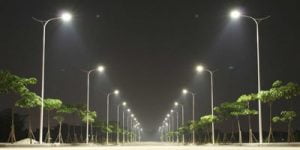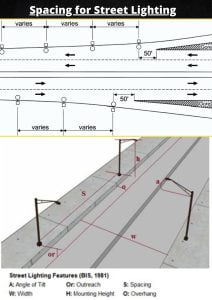Table of Contents
In this article, we will discuss street lighting.
1. Introduction
Street lighting is provided on the side of the road or within the median or suspended over a wire above the road to provide illumination, lightning should be always kept at signalized intersections and circular intersections.
In order to have safer, more comfortable, more convenient, sufficient movement of vehicles and pedestrians at night time, street lighting or highway lighting is needed along the road.
Lighting should be managed well, it should permit night traffic operations with maximum possible safety, comfort, and convenience.
It should be well managed in such a way that the driver should be comfortable to view more clearly and watch all the important details while driving.
2. Importance of Street lightning
Street lighting is to authorize road users to view accurately and easily the carriageway and the quick surroundings in darkness.
Street lighting enhances visibility at night through artificial lighting decreases stress on driving and makes sure comfort.
It feels very easy to drive a vehicle in the presence of street lighting.
With the help of street lighting traffic speed can be improved and traffic flow conditions can be made better.
Street lighting is very necessary at intersections, bridge sites, level crossings, and places where traffic movements are banned.

3. Types of Street Lighting
a. Single Side Light System
This system is very cheap and best for small pavements for very small traffic conditions.

b. Staggered Light System
This system is best for wide pavement and light traffic.

c. Central Light System
This system gives very sufficient lighting at a low cost due to savings in luminaire support and electrical conductors.
It provides consistently well lighted on the road without interruption, but the pavement and bicycle path is relatively dark.

4. Design Factors for Highway Lighting
1. Size, color, and brightness of the object
The visibility at night always depends on the size, color, and brightness of the object.
2. Contrast
Contrast is more necessary that there is enough color contrast between the object and its background so that an object can be seen on the road, hence visual performance at the time of night driving depends on contrast.
The method of discernment is as follows:
a. Discernment by silhouette
It is a barrier that can be seen as a dark field against a bright background.
The brightness and consistency of the road pavement and crossing the roadway are necessary to increase the discretion by silhouette.
b. Discernment by reverse silhouette
It is a barrier that can be seen bright against a dark background.
This principle method is done to areas adjacent to roadways and projections above the surface of the pavement to have good visibility.
3. Drivers Eye Glare
There are a few types of glare that seriously cause effects on the driver’s visual action.
The different types of glare are as follows:
Physiological glare
Physiological glare is also known as a disability glare that evolves from stray light, which damages visual efficiency due to decreased visual efficiency.
This type of glare can be lowered by enhancing mounting height, moving the luminaire from the line of sight, and enhancing the brightness of the background.
Psychological glare
It is also called discomfort glare occurs because of ocular discomfort from a bright light source.
Such brightness can be decreased by enhancing the height and background brightness decreasing the luminaire brightness.
4. Lamps
Lamps that are majorly used in developed as well as the undeveloped country for street lighting are sodium vapor lamps, tungsten filament lamps, mercury vapor lamps, and fluorescent lamps.
| Read Also: Solar Tree |
5. Lateral Placement of Lighting Poles
According to I.R.C, the road poles should be placed with horizontal clearance from the pavement edge:
i. For roads with raised curbs like urban roads, the minimum horizontal clearance is 3 m and it can be 0.6 m from the edge of the lifted curb.
ii. For roads without lifted curbs as rural roads, the less horizontal clearance is supposed to be 1.5 meters from the edge of the carriage and less than 5 meters from the line of the middle of the carriageway.
6. Layouts of Lighting or Arrangement of Lamps
Street lights can be managed in various systems noted below:
a. Single Side Light System.
b. Staggered light System.
c. Central Light System.
d. Contrast lighting.
e. Combination of central, staggered, and contrast lighting systems.
7. Luminaire Distribution of Light
The luminaire distribution of light should be well managed to get desirable use of the source of light or luminaire.
The light should be adjusted such that it spread all over the pavement between the curbs and the luminaire distribution of light should focus on the pavement and the surrounding area from 3 m to 5 m.
The distribution of light should be more clear so that traffic signs and other objects on the road can be visualized easily and it should be regular, bright and the pavement should cover more area.
8. Mounting Height and Overhang
The height and overhang of the lamp from the pole are more important because the distribution of light, shadow, and brightness effects from street lamps depends on the height of the lamp and its overhang.
The height of the street pole can vary from 6 meters to 9 meters, the enhancing value of lamps is more favorable to main urban roads.
The lamp’s overhang from the pole provides a good distribution of light on the pavement and authorizes less glare in the eyes of road users.

5. Spacing for Street Lighting
It should have a closer spacing of lights so that the road has suitable brightness and visibility during the night.
The spacing of light turns on the importance and traffic volume of the highway or road.
From various experiments, the normal distance is kept to be from 35 m to 55 m for best brightness and visibility during the nighttime for all types of roads.
The difference between pales on highways can be calculated from the following statement as follows:
| Lamp lumen x coefficient of utilization x maintenance factor/average flux x width of the road. |
Note that the maintenance factor is taken to be 0.8 coefficient of utilization can be calculated from the utilization coefficient charts.

6. Advantages of Street lighting
The advantages of street lighting are as follows:
a. Due to proper street lighting, vehicle drivers, as well as the police, can do patrol at night time and their job becomes easier and more convenient.
b. Increases the business in a city or town, areas during the night that would otherwise be fully uninhabited.
c. Architects and town planners have considered lighting as a major source for the beautification of their projects.
d. Due to good street lighting, the accident rate during the night reduces significantly.
e. The illegal works on the streets and anti-social activities are can be controlled and discouraged with the help of street lighting techniques.
f. It provides a good atmosphere and increases the aesthetic beauty of the road at night.
7. Disadvantages of Street Lighting
The disadvantages of street lighting are as follows:
a. Sometimes street lighting is an expensive process.
b. During fixing, it can affect the road structure.
c. It needs a sufficient volt of electricity.
| Read More: Curb and Gutter |

